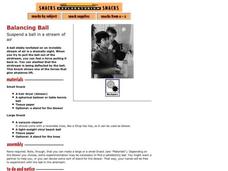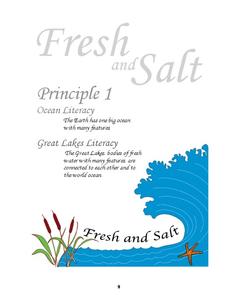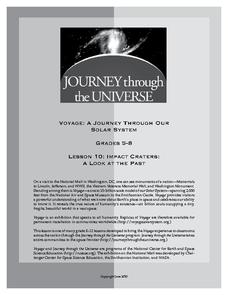Exploratorium
Balancing Ball
Demonstrate lift to the class that is studying aerodynamics. In the stream of air produced by a blow dryer, little physicists place a wad of tissue paper and a spherical figure to compare. Or, if you have a vacuum cleaner and beach ball,...
Exploratorium
Radioactive Decay Model
Toss 100 pennies (or poker chips or any other two-different-sided objects) and remove all of those displaying tails. Line them up and repeat. The lines of pennies collected get smaller each time, successfully representing half-life.
Common Core Sheets
Finding Side Length (Given Perimeter)
Perimeter is the total distance around an object. One can find the perimeter of a rectangle or square by adding all four side lengths together. These worksheets require third graders to find the missing side length, given the...
Scholastic
Study Jams! Transformations
Flip, spin, and shift with this vocabulary-rich video on transformations. Learners watch different movements and see how to move an object without affecting its size. The video follows with a multiple choice assessment that...
Concord Consortium
Charge Intensity and Electric Force
Looking for a quick way to supercharge your electricity and magnetism unit? Assign a very responsive interactive designed to illustrate the relationship between charge, electric field, and the resulting forces. Learners experiment with...
Centers for Ocean Sciences
Ocean and Great Lakes Literacy: Principle 1
Is your current lesson plan for salt and freshwater literacy leaving you high and dry? If so, dive into part one of a seven-part series that explores the physical features of Earth's salt and freshwater sources. Junior hydrologists...
Curated OER
Use A or An?
Young readers observe a labeled object and circle the article a or an that proceed the word, write the articles before illustrated words, and choose the correct word in parenthesis to complete sentences. Everyone writes 29 answers.
Florida Center for Reading Research
Syllable Hopscotch
Let your little learners move while they practice breaking words into syllables or chunks. Place a hopscotch "board" on the floor (this can be done with tape). Your class takes turns choosing picture cards, and then they say the name of...
Curated OER
Responding Syllables: Reading and Music
Shell Silverstein’s “Sick” provides an opportunity for kids to demonstrate their understanding of syllables and phonemes. The class creates a list of descriptive words used in the poem that have more than one syllable, and brainstorm how...
Super Teacher Worksheets
Counting Memory Match Game
What a fun way to practice counting! Print these cards for an easy go-to matching game. Partners take turns playing a memory game, flipping the cards over to try to match a number with the card that has the corresponding number of...
Positively Autism
Activities for "Decreasing Supermarket Tantrums"
Priming and shaping, two teaching strategies used to prepare kids for upcoming activities, are detailed in this resource that models how to prepare kids for a trip to the supermarket. Activities include creating a shopping list,...
Journey Through the Universe
Impact Craters: A Look at the Past
The Galle crater on Mars is also known as the Happy Face crater because of its appearance. First, scholars use pebbles and flour to simulate craters and study their properties. They then apply this knowledge to help decipher the history...
PhET
Radioactive Dating Game
Uranium 235 has a half-life of over 700 million years and is the fuel used in the atomic bomb dropped on Hiroshima, Japan. Pupils see the half-lives and decay rates of Carbon-14 and Uranium-238. They also take measurements of these two...
PHET
Forces and Motion
The average American will move 12 times, which results in a lot of moving furniture! Class members consider the forces required to move objects with a creative simulation that opens with the forces required to push a filing cabinet....
Physics Classroom
The L.O.S.T. Art of Image Description - Converging Lenses
Magnifying glasses and cameras often use converging lenses, but how do they alter an image? Pupils discover a lens, axis, and object arrow before identifying four characteristics of the resulting image. They label the location,...
Physics Classroom
Color Pigments
Objects contain pigments that selectively absorb a wavelength of light, and our eyes only observe a very small range of these wavelengths. Scholars apply these two facts to three different activities. They identify the pigment in an...
College Board
2009 AP® Computer Science A Free-Response Questions
Coding and decoding is part of the work. Pupils and teachers use the released questions from 2009 to gather information on how topics show up on the AP Computer Science exam. The four questions range from the array data structure to...
Perkins School for the Blind
Mix and Match
Sorting and matching are skills that have all kinds of applications. Learners with low, but useable vision work to match an object to an object, an object to a picture, and a picture to a picture. This will help them identify objects...
Mathematics Vision Project
Module 5: Modeling with Geometry
Solids come in many shapes and sizes. Using geometry, scholars create two-dimensional cross-sections of various three-dimensional objects. They develop the lesson further by finding the volume of solids. The module then shifts...
Curated OER
Narrow It Down
Ever played 20 Questions? A similar game helps young learners practice asking and answering yes-or-no questions. Spread out several objects, preferably all similar with slight variations (buttons or coins would work well). A leader...
Florida Center for Reading Research
Phonics, Letter-Sound Correspondence: Letter Bag
An activity focuses on final sounds sorting. Scholars pull objects out of a bag, identify what letter sound the object ends with, then draw the picture under the appropriate column.
Illustrative Mathematics
Tossing Cylinders
Everyone loves a lesson that involves throwing things around! To understand probability, your experimenters will predict how different cylinder-shaped objects will land when tossed. When the data is collected, they will calculate the...
Curated OER
CPO Science - Foundations of Physics
An object in motion will remain in motion, and your physics learners will really get moving by viewing this PowerPoint! They examine each of Newton's laws of motion, learning about force, inertia, acceleration, and equilibrium. They are...
K12 Reader
Push and Pull
For this comprehension exercise, kids read a physical science article about forces that can move an object, and then answer a series of questions about the passage.
Other popular searches
- Classroom Objects
- Direct Objects
- Direct and Indirect Objects
- Classifying Objects
- Classify Objects
- School Objects
- Classroom Objects Bingo
- Indirect Objects
- 3 D Objects
- Counting Objects
- 3 Dimensional Objects
- Describing Objects























